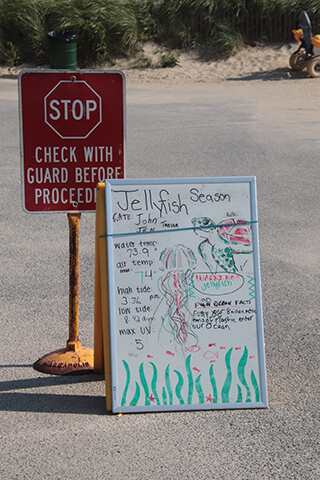 Cape Cod, renowned for its stunning coastline and rich marine biodiversity, is home to a captivating array of jellyfish species. Jellyfish on Cape Cod can typically be found off the coast during the warmer months, from late spring to early fall. Their presence can vary depending on water temperature, currents, and other environmental factors.
Cape Cod, renowned for its stunning coastline and rich marine biodiversity, is home to a captivating array of jellyfish species. Jellyfish on Cape Cod can typically be found off the coast during the warmer months, from late spring to early fall. Their presence can vary depending on water temperature, currents, and other environmental factors.
As visitors and locals alike flock to the Cape Cod shores every summer, it’s crucial to appreciate these creatures while also taking precautions to ensure a safe visit to the ocean.
During the warmest months of peak season, when the warmer water temperatures are conducive to their growth and reproduction, you are more likely to encounter several species of jellyfish. Also during this period, you will notice various signs and closures throughout beaches on the Cape, alerting you to their presence.
The Types of Jellyfish on Cape Cod
1. Moon Jellyfish (Aurelia aurita)
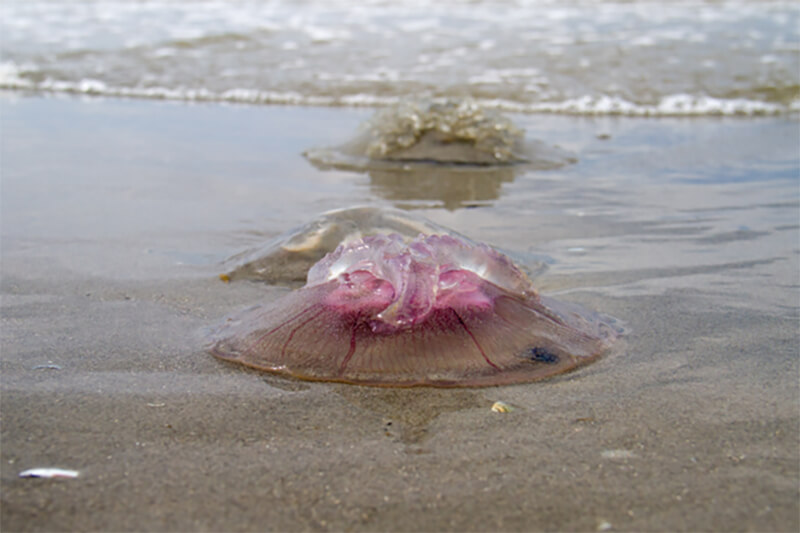
One of the most common jellyfish species found in Cape Cod waters, the Moon Jellyfish, showcases a translucent bell-shaped body with delicate, moon-like markings across its surface. Its four horseshoe-shaped gonads are easily visible and add a touch of artistry to its appearance. Despite their widespread presence, Moon Jellyfish have relatively mild stinging cells, making encounters with swimmers less likely to result in discomfort.
2. Lion’s Mane Jellyfish (Cyanea capillata)
A true giant of the jellyfish world, the Lion’s Mane Jellyfish is known for its impressively long tentacles, which can extend up to several meters in length. These tentacles are adorned with stinging cells that pack a more potent punch than those of the Moon Jellyfish. Characterized by its fiery red or yellow hue, this species is a captivating yet potentially painful sight for those venturing into Cape Cod’s waters.
3. Sea Nettles (Chrysaora spp.)
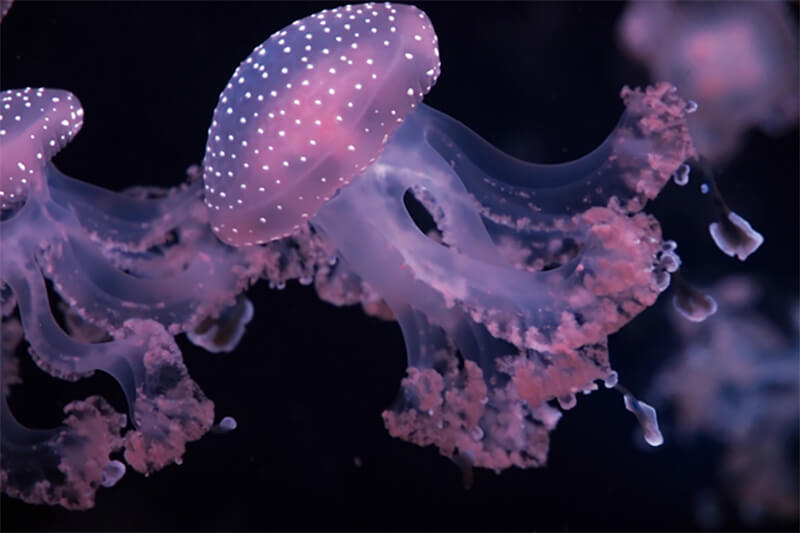
Sea Nettles encompass a variety of jellyfish species, including the Atlantic Bay Nettle, a species more commonly found further south. It is believed that warming waters and rainfall run-off this summer may have created the ideal environment for these jellyfish to thrive locally on the Cape this summer.
With gracefully trailing tentacles and intricate patterns on their bell-like bodies, Sea Nettle stings are typically not as severe as those of their tropical counterparts, caution is advised when encountering them.
4. Comb Jellyfish (Mnemiopsis leidyi)
In contrast to the gelatinous appearance of traditional jellyfish, Comb Jellyfish possess a transparent, nearly ethereal quality. These mesmerizing creatures are known for their bioluminescence, creating a stunning display of twinkling lights in Cape Cod’s waters at night. Unlike most jellyfish, Comb Jellyfish are not equipped with stinging cells and are harmless to humans.
5. By-the-Wind Sailor (Velella velella)
Although not a true jellyfish, the By-the-Wind Sailor is often mistaken for one due to its similar appearance. These small, blueish creatures feature a sail-like structure that helps them catch the wind and sail across the ocean’s surface. While they don’t pack a painful sting, their presence can be a sign of larger ocean currents and ecosystems.
6. Portuguese Man-of-War (Physalia physalis)
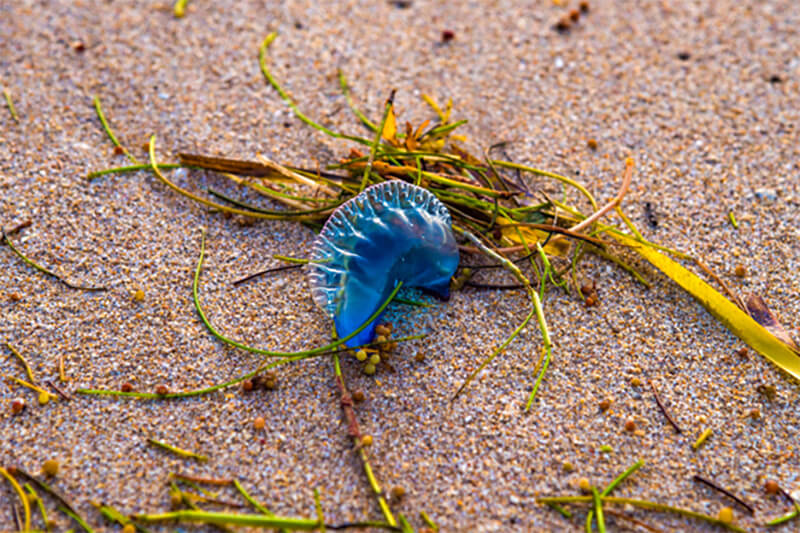
Sometimes drifting into Cape Cod waters, the Portuguese Man-of-War is another species often mistaken for a jellyfish. In reality, it is a colony of specialized organisms known as zooids.
Both Chatham and Yarmouth have had beach closures this summer due to sightings of the Portuguese-Man-of -War. Many other beaches have posted cautionary signs. While awe-inspiring, it’s important to maintain a safe distance from these creatures. Its long, vibrant tentacles are equipped with powerful stinging cells that, while rarely deadly, can cause painful stings to humans.
7. Sea Blubber Jellyfish (Cyanea lamarckii)
With its iridescent bluish hue and trailing tentacles, the Sea Blubber Jellyfish is a true embodiment of the otherworldly charm that jellyfish possess. While their stinging cells are less potent than those of some other species, they can still lead to discomfort upon contact.
Stay Informed of Local Advisories
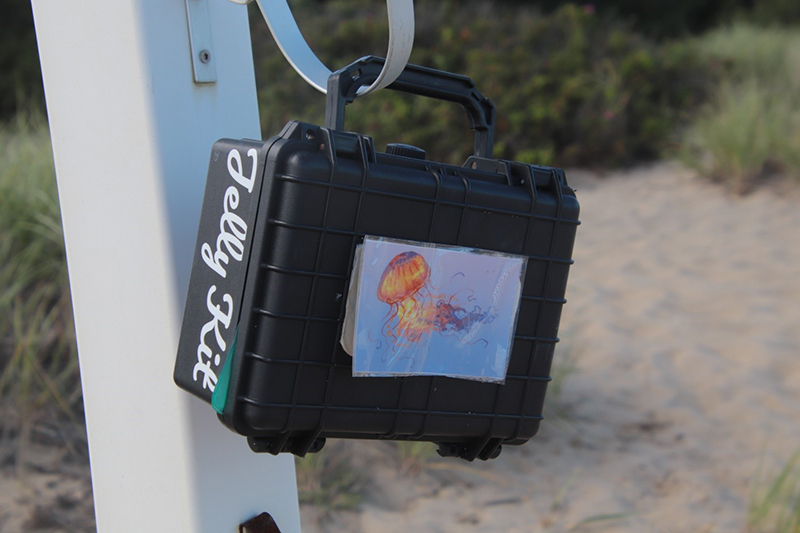
If you’re planning to swim or engage in water activities off Cape Cod during the warmer months, it’s a good idea to be aware of the potential for jellyfish encounters and take precautions such as wearing protective clothing or checking local beach advisories before entering the water.
If you are stung, immediately seek out the lifeguard or other medical attention. Most lifeguard stations will have a jellyfish sting kit. Along the mile and a half stretch of Popponesset Beach in Mashpee you will find 14 self-administering kits equipped with the supplies necessary to treat a sting.
Exploring the variety of jellyfish species off the coast of Cape Cod is a reminder of the diverse and delicate marine ecosystems that thrive in these waters. From the gentle grace of Moon Jellyfish to the awe-inspiring spectacle of the Lion’s Mane, these gelatinous creatures, with their vibrant colors, are a fascinating part of the Cape’s marine ecosystem.









